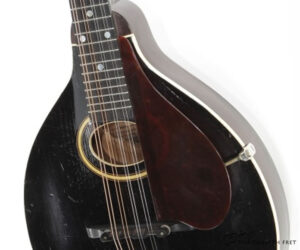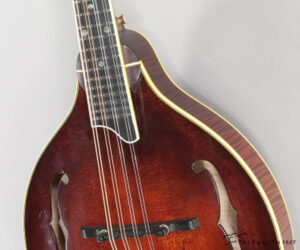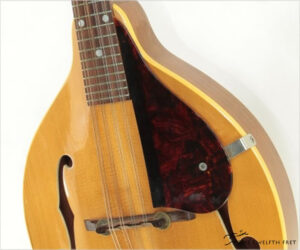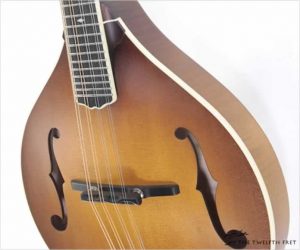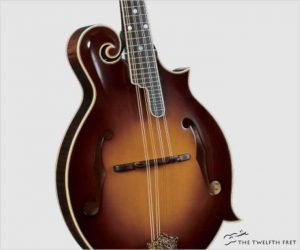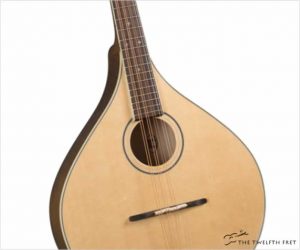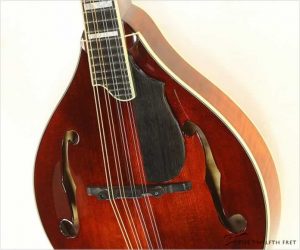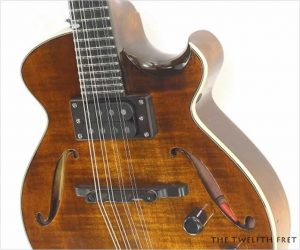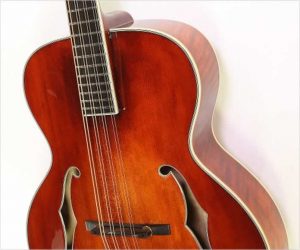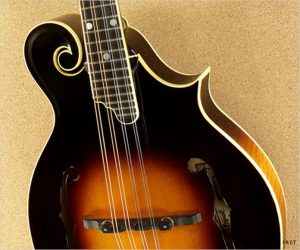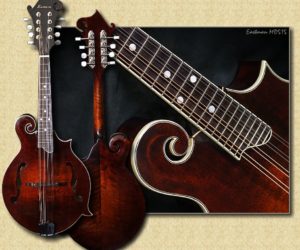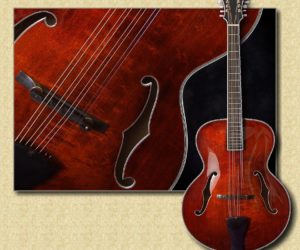Here we’re looking at a Gibson Style A ‘Snakehead’ Black-top mandolin in A-1 trim from 1927 in overall good and largely original condition. The ‘Snakehead’ term refers to the tapered headstock, an innovation by Lloyd Loar that reduced string friction at the nut. ‘Snakehead’ models were built from 1923 to 1927.
Mandolins
Shown here is a beautiful Michael Heiden A-29 Deluxe A-Style mandolin, built during 2003 in Chilliwack, British Columbia. Michael Heiden has been building quality instruments since the 1970’s and his work is highly respected. Originally working in Vancouver as a musician, repairman and builder, he moved to Chilliwack and since then to Creston, B.C.
Introduced in 1948 and built until 1971, the Gibson A40 was offered as a high quality entry level instrument. This example dates to 1957 and is in overall good condition, plays well and has a bright yet warm tone with plenty of volume and projection. The original fibre case is included, as well as a more recent hard shell case.
Here we have a Weber A14-F mandolin, an A-style, 14 inch scale, F-hole version of Weber’s Bitterroot model. This mandolin features a carved & graduated spruce top with tone bars, lightly figured maple back & sides, a maple neck with radiused ebony fingerboard, ebony Weber bridge, cast Weber tailpiece, raised fingerboard extension, full 14″ scale length and ivoroid top binding! This instrument is set up to play as smooth as butter and with the maple back & sides in combination with the delicately voiced top and tone bars
The Kentucky KM-1500 Master F-Model Mandolin – Vintage Sunburst uses the finest, most highly figured Michigan Maple combined with the whitest, most fine-grained Adirondack Spruce. These solid woods are meticulously hand carved and graduated — just as were the fabled originals of the early ’20s — to achieve the finest tone quality and volume possible in a new instrument.
Trinity College mandolins are designed for traditional Celtic music, though they are used in a wide variety of other styles, too. The traditionally styled body of the TM-325 Octave Mandolin is complimented by an elegant snakehead peghead with the new Celtic-inspired cross. Its rich, mellow tone and great projection will surprise you!
The Eastman MD605 represents great value in a quality A-Style mandolin, built with solid woods and wrapped in a gloss nitrocellulose lacquer finish. Introduced in 1905 and based on Orville Gibson’s patent merging violin family techniques with guitar and mandolin construction, the A-Style mandolin has a distinctive teardrop shape and a carved top and back, with either F holes or an oval hole; the F hole provides somewhat more top end. Compared to the F style often seen in bluegrass bands, the A Style body shape has more pronounced midrange and fundamental, and a less percussive attack.
Eastman El Rey ER-M Mandolin is very cool instrument that shares DNA with the Eastman archtop El Rey models, creating a contemporary looking electric mandolin. The Eastman El Rey ER-M features a solid one piece mahogany sides and back with a solid maple top. The mahogany provides enhanced mid range warmth and the maple top has a focused note fundamental with clear top end snap. The two f holes provide a bit of traditional mandolin looks but the single cutaway and lower bout design really give it that jazz box feel.
The Eastman MDC805 Mandocello is a wonderful, rich sounding instrument that works well as a solo, ensemble or accompaniment instrument in a wide range of styles and genres, from Celtic to Classical, Latin and back again. The Mandocello had been in existence for some centuries in Europe, beginning with flat back and then bowl back. However, in 1905 Orville Gibson’s company began producing mandolin family instruments, including Mandocello models that drew from his blending of violin and guitar concepts.
This Capek F5 Basic Mandolin model, and it is impressive. The build quality is very high and the instrument sounds great and plays extremely well.
The MD515 was the mandolin that re-shaped the entire mandolin market in my opinion. a couple of years ago it was unthinkable that an all solid wood, true hand carved & graduated f-style mandolin could be offered in the under $1600.00 price point.
After the success of Eastman’s line of handcarved, solid mandolins it was only a matter of time before the master luthiers brought their skills to bear on other members of the mandolin family. The Eastman mandocello utilizes all the best features of a great Eastman archtop guitar. By accenting the lower fundamentals with ringing archtop overtones they have produced an instrument that matches and perhaps surpasses any mandocello in the market today!
Eastman Strings was founded in 1992, yet it is already an integral part of the long and glorious history of one of the most fascinating musical traditions the world has known. Through our violin and bow making activities, we at Eastman Strings are attached to a tradition nearly 500 years old, and we strive to maintain a level of artistic and commercial achievement worthy of our predecessors.
